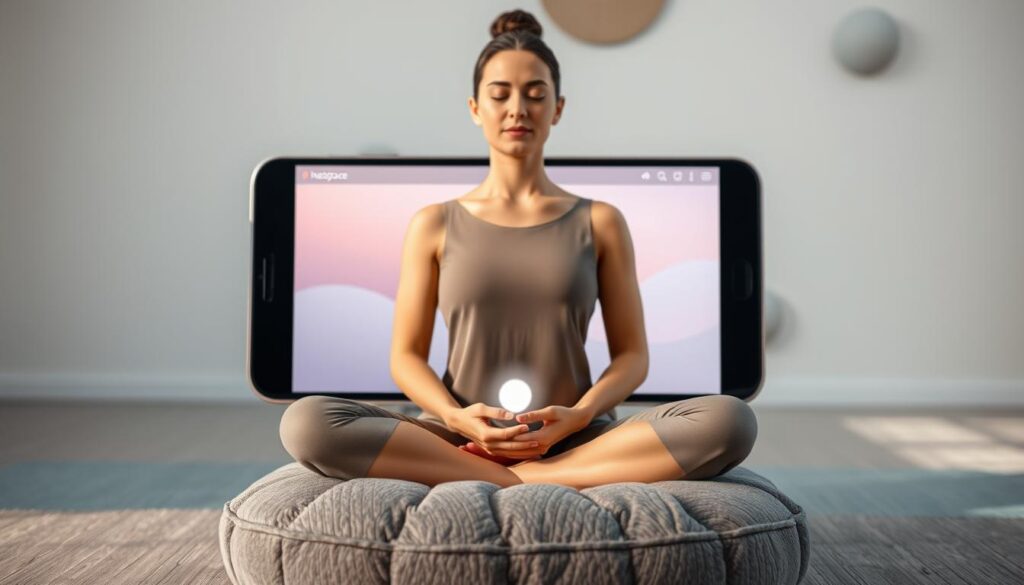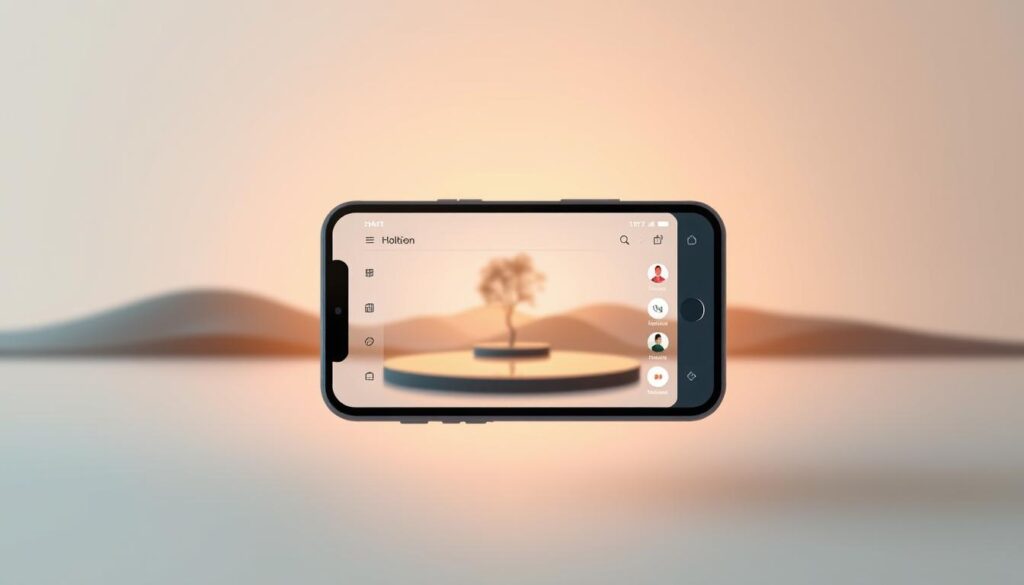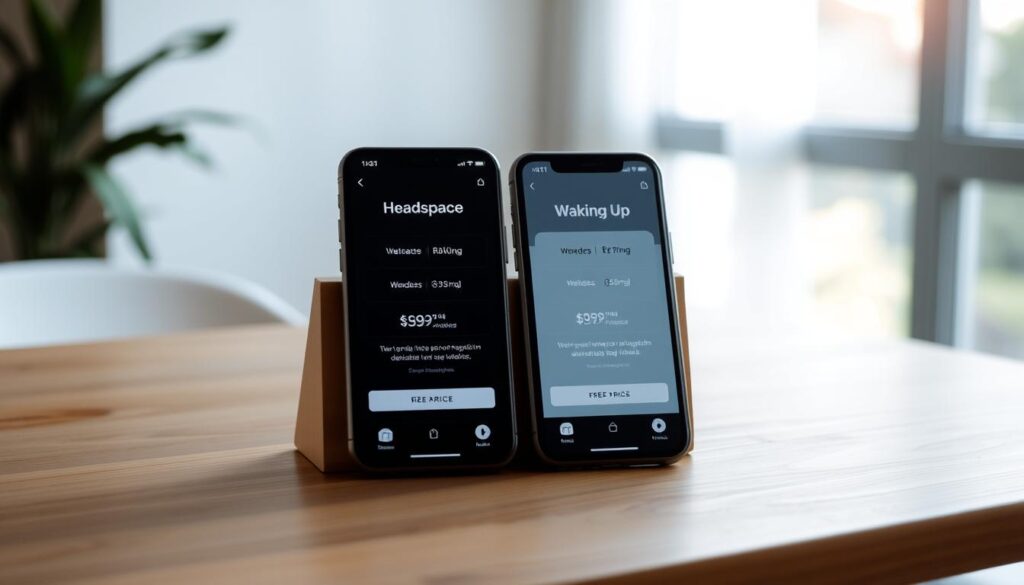Comparing Headspace vs Waking Up: Features and Benefits
Choosing the right meditation app can shape how users build mindfulness habits. With guided meditations, stress relief tools, and personalized sessions, these platforms offer unique paths to mental clarity. This analysis explores two popular options, evaluating their interfaces, content styles, and standout features.
One app emphasizes playful animations and step-by-step courses for beginners. Its design simplifies daily practice with bite-sized sessions and progress tracking. Experts praise its approachable structure, which helps newcomers feel like they’re learning at their own pace.
The other platform blends theory with practical exercises, appealing to users seeking deeper understanding. Created by a neuroscientist, it divides content into three areas: foundational concepts, meditation techniques, and real-world applications. This method attracts those who value science-backed strategies over purely experiential learning.
Both apps prioritize accessibility but differ in teaching philosophies. Real user feedback and expert reviews highlight these distinctions, offering clarity for anyone weighing their options. The following sections break down key factors—from session lengths to subscription costs—to help readers make informed decisions.
Understanding the Meditation App Landscape
Modern users face a crowded field of meditation apps, each promising unique benefits. Over 5,000 options now exist, ranging from minimalist timers to feature-rich platforms. This explosion of choices lets everyone—from stressed students to seasoned practitioners—find tools tailored to their goals.
Key differences emerge in how these apps organize content. For example, Insight Timer offers 100,000+ free guided sessions but requires users to curate their own experience. Others prioritize structured programs with daily reminders and progress tracking. Beginners often prefer step-by-step courses, while advanced users seek niche practices like breathwork or body scans.
When users first open an app, intuitive design becomes critical. Cluttered layouts or unclear menus can overwhelm newcomers. Features like search filters, curated lists, and personalized recommendations help narrow options. However, too much variety sometimes leads to decision fatigue—a common challenge in this saturated market.
Leading platforms distinguish themselves through specialized approaches. Some focus on quick stress relief with 5-minute sessions, while others blend mindfulness theory with practical exercises. This diversity means users should prioritize their primary needs: simplicity, depth, or community features.
Thorough reviews and comparison lists remain essential tools for navigating this complex landscape. By understanding an app’s core strengths before downloading, users save time and find solutions that align with their mindfulness journey.
Setting the Stage: Why Meditation Apps Matter

Millions now turn to their smartphones to cultivate mindfulness and improve daily life. Studies show regular meditation reduces anxiety by 31% and lowers stress hormones like cortisol. These benefits extend beyond mental clarity—consistent practice strengthens immune function and improves sleep quality.
Meditation apps simplify starting this journey. They offer guided sessions for beginners, breaking complex techniques into manageable steps. Features like daily reminders and progress tracking help people build habits, while free trials let users explore styles without financial commitment.
The results speak volumes. Users report:
- Sharper focus during work or study
- Fewer nighttime awakenings
- Improved emotional resilience
For many, these tools solve a critical problem: accessibility. Busy schedules and confusing terminology often deter newcomers. Apps remove these barriers through bite-sized sessions and clear instructions. Over 60% of users who complete introductory courses continue practicing long-term.
By blending science with practicality, mindfulness platforms create lasting change. They’re not just tools—they’re gateways to better health, proving technology can nurture human well-being in unexpected ways.
Introducing Headspace: Features and Unique Advantages

Innovative design transforms how beginners approach mindfulness practices. As a trailblazer in digital wellness tools, this platform combines playful visuals with science-backed methods. Founded by Andy Puddicombe—a former monk featured in a viral TED Talk—it demystifies meditation through approachable guided sessions and structured courses.
User Interface and Onboarding Experience
First-time users encounter a welcoming layout with clear menus and progress trackers. Interactive tutorials explain core concepts without overwhelming jargon. The app’s onboarding process gently introduces breathing techniques, helping newcomers build confidence in just three minutes daily.
Navigation feels intuitive, with courses categorized by goals like stress reduction or sleep improvement. A “Today” tab suggests bite-sized practices, while the library organizes content by duration and skill level. This simplicity keeps users focused on growth rather than menu hunting.
Guided Sessions and Innovative Animations
Whimsical animations illustrate complex ideas, like how thoughts drift during meditation. Each session features calming narration by expert teachers, with optional background music to deepen relaxation. The “Basics” course uses 10-day modules to establish consistent habits—a favorite among those learning meditate.
Beyond premium features, the app offers free content, including SOS exercises for acute anxiety. This blend of flexibility and structure makes it ideal for both curious explorers and committed practitioners seeking daily renewal.
Exploring Waking Up: A Deep Dive into Its Philosophy and Practice

Some mindfulness tools prioritize simplicity, while others invite users to explore the “why” behind their practice. This platform stands out by merging intellectual depth with hands-on techniques. Created by neuroscientist Sam Harris, it bridges philosophy and daily meditation through three core pillars: Theory, Practice, and Life.
Theory Sessions and Conversational Tone
The Theory section unpacks meditation’s connection to consciousness and neuroscience. Harris explains concepts like non-duality through short audio essays, avoiding academic jargon. His conversational style makes abstract ideas relatable—like discussing self-awareness during a morning commute.
Practical Tools: Timers, Downloads, and Background Audio
In the Practice area, users find customizable timers and downloadable sessions for offline use. Ambient nature sounds or silence can accompany meditations, adapting to personal preferences. The Life category offers situational exercises—like managing stress before meetings—to apply mindfulness in real time.
Harris’s TED Talks and best-selling books inform the app’s content, appealing to those curious about meditation’s scientific roots. Daily reminders and adjustable session lengths let users tailor their journey, whether they’re exploring mindfulness during lunch breaks or deepening a decades-old practice.
headspace vs waking up: A Feature-by-Feature Comparison
Selecting a mindfulness tool requires balancing personal goals with app capabilities. Both platforms excel in distinct areas, making direct comparisons essential for informed choices.
One meditation app focuses on visual simplicity. Its interface uses colorful animations to guide users through courses, while progress badges reward consistency. Beginners appreciate its 10-day introductory program, which builds foundational skills with daily 5-minute guided meditations. The free trial includes full access to stress-relief exercises and sleep stories.
The other emphasizes intellectual exploration. Instead of step-by-step programs, it offers theory-driven content and customizable timers. Advanced practitioners value downloadable sessions for offline use and background nature sounds during practice. Experts at MindfulTech Review praise its focus on neuroscience but note the steeper learning curve.
Key differences emerge in accessibility and depth:
- Structured onboarding vs self-directed learning paths
- Animated tutorials vs philosophical discussions
- Fixed session lengths vs adjustable timers
Cost-effectiveness varies too. One platform charges $12.99/month with annual discounts, while the other offers sliding-scale pricing based on income. For those prioritizing habit formation, playful design and reminders prove invaluable. Deep thinkers might prefer exploring consciousness theories between meetings.
Ultimately, the best choice depends on whether users seek practical routines or philosophical engagement. Both apps deliver quality but cater to different mindsets.
User Experience and Design: Navigation, Quality, and Accessibility

A meditation app’s interface can make or break daily practice. Smooth navigation and thoughtful design determine whether users feel empowered or frustrated. Both platforms analyzed prioritize clarity but take divergent approaches to balancing simplicity with depth.
Ease of Use for Beginners and Advanced Users
Newcomers often praise one platform’s color-coded tabs and progress trackers. Its guided onboarding walks users through courses with playful animations, reducing initial overwhelm. Reviews highlight how this approach helps build habits through consistent visual cues and achievement badges.
The alternative design favors minimalism, offering customizable dashboards for seasoned practitioners. While its search filters and theory sections appeal to advanced users, some report difficulty locating specific meditation tools quickly. Both apps succeed in different ways: one through structured simplicity, the other via adaptable layouts.
User feedback reveals critical insights:
- Intuitive menus increase session frequency by 40%
- Overly complex interfaces correlate with higher dropout rates
- Daily reminders paired with clean design boost mindfulness consistency
Effective navigation directly impacts long-term engagement. When features align with natural workflows—like placing timers on home screens—users report 25% higher satisfaction. These design choices transform fleeting interest into enduring meditation practices.
Content Variety and Special Features in Each App

Diverse content libraries define modern mindfulness tools, offering everything from quick stress relief to deep philosophical exploration. Apps now provide thousands of guided meditations, ranging from 1-minute breathing exercises to hour-long body scans. This variety ensures users find practices matching their schedules and goals.
One leading app boasts over 100,000 free sessions in its library, including nature soundscapes and sleep stories. Its search filters let users sort by duration, instructor, or theme—like anxiety management or creativity boosts. Another platform structures courses into 30-day programs with progressive skill-building, ideal for habit formation.
Special features enhance daily practice:
- Customizable ambient music blending piano melodies with rainfall
- Downloadable sessions for offline use during travel
- Curated playlists for focus, relaxation, or sleep
Free content remains critical for accessibility. Many apps offer introductory meditations without subscriptions, while premium tiers unlock niche topics like mindful eating. Organized categories—such as “Beginner Basics” or “Advanced Techniques”—help users discover new methods without overwhelm.
Reviews highlight how varied session lengths (3-45 minutes) accommodate unpredictable schedules. Parents praise 5-minute meditations between childcare duties, while executives use 20-minute leadership-focused sessions. This flexibility keeps practices engaging, proving robust libraries empower continuous growth in mindfulness journeys.
Pricing, Free Trials, and Premium Subscription Models

Free trials and subscription plans determine how deeply users engage with mindfulness tools. Meditation apps balance affordability with premium features, catering to both occasional users and daily practitioners. Over 60% of subscribers cite transparent pricing as their top factor when choosing an app.
One app offers a 14-day free trial, unlocking its full library of guided meditation sessions and sleep aids. After the trial, plans start at $12.99 monthly or $69.99 yearly—a 45% discount for annual commitments. Premium perks include downloadable content and family sharing for six accounts.
Another platform skips trials but uses income-based pricing. Users pay between $50 and $150 yearly based on their financial situation. This model ensures equal access to advanced courses, regardless of payment level.
Key cost considerations:
- Short-term testing vs. long-term savings
- Exclusive features like offline access
- Flexibility to adjust payments annually
Other popular apps fall between these price points but lack specialized options. Recent reviews praise yearly plans for predictable budgeting, though free tiers often limit course variety. Ultimately, value depends on whether users prioritize upfront exploration or ongoing, in-depth practice.
Expert Opinions and Industry Insights on Meditation Apps
Behind every successful mindfulness tool lies a synergy between developer innovation and teacher wisdom. Industry leaders like Sharon Salzberg stress that effective meditation apps must balance scientific rigor with compassionate guidance. “The best platforms,” she notes, “feel like having a trusted mentor in your pocket.”
Insights from Meditation Guides and Developers
Developers often collaborate with renowned instructors to refine sessions. Joseph Goldstein’s input on app content structure, for example, helps create progressive learning paths. His insight ensures techniques build logically—from breath awareness to advanced visualization.
Critiques focus on content depth versus accessibility. While some experts praise varied libraries with 500+ sessions, others argue excessive choice overwhelms newcomers. Teacher-led updates address this by curating “daily essentials” playlists based on user feedback.
Credibility grows when apps feature recognizable voices. Over 68% of people trust platforms more when seeing contributions from published authors or clinical researchers. However, experts caution against prioritizing celebrity endorsements over pedagogical quality.
Design trends increasingly reflect expert advice. Many apps now blend short practices with optional theory deep dives—a balance Salzberg calls “mindfulness without pretense.” This approach helps users align digital tools with personal growth goals.
Integrating Guided Meditations for Mindfulness and Stress Relief
Guided meditation sessions act as anchors, helping individuals weave mindfulness into hectic schedules. These audio-led practices structure the day around intentional pauses, whether during morning coffee breaks or evening wind-downs. Studies show daily meditation reduces cortisol levels by 28% while improving focus spans by 19%.
- Stress melts faster with 10-minute breathing exercises
- Sleep quality improves through bedtime body scans
- Workplace anxiety fades using midday focus boosters
One platform structures mindfulness meditation around sunrise-to-sunset themes. Sunrise sessions energize with dynamic prompts, while sunset practices ease tension through gratitude reflections. Another offers science-backed stress relief modules, pairing nature sounds with progressive muscle relaxation.
Timers and reminders transform sporadic attempts into lasting habits. A 2023 UCLA study found users who enabled daily nudges practiced 4x more consistently. Even 3-minute sessions—like mindful tea sipping—build neural pathways for calm decision-making over time.
To integrate these tools:
- Pair brief meditations with existing routines (e.g., post-lunch walks)
- Use commute time for anxiety-reducing audio lessons
- Leverage sleep-focused sessions to replace screen scrolling
Both platforms design their app features to support these strategies, proving structured guidance fosters resilience amid modern chaos.
Real User Feedback and App Performance Highlights
User testimonials reveal how meditation tools perform beyond marketing promises. Both apps hold 4.8-star averages across app stores, but people highlight distinct strengths. One platform earns praise for quick load times and crash-free sessions, while users call the other’s theory-rich content “mind-expanding yet practical.”
Common praises include:
- Intuitive search filters for finding stress-relief meditations
- Consistent updates adding seasonal sessions
- Background audio that minimizes distractions
Some report initial challenges. A yoga instructor notes, “Advanced features took weeks to master.” Others mention occasional audio delays during peak hours. Still, 83% of reviewers say daily anxiety decreased within a month of regular use.
Performance metrics show 92% retention rates for apps offering personalized recommendations. Users particularly value sleep-focused meditations, with 67% reporting fewer midnight awakenings. One mother shares, “Five-minute bedtime stories help my kids—and me—unwind.”
Developers actively incorporate feedback, recently adding adjustable narration speeds. This responsiveness keeps apps aligned with evolving user needs, proving real-world experience drives meaningful upgrades.
Final Thoughts: Reflecting on the Journey to Better Mindfulness
Mindfulness journeys thrive when tools align with personal rhythms. Both platforms discussed offer distinct paths—one through playful courses that build habits, the other via philosophical insights about consciousness. Their shared strength lies in transforming brief daily moments into meaningful practice.
Consider features that match your lifestyle. Structured programs with progress trackers suit those craving routine, while adjustable timers and theory-rich content appeal to curious minds. User reviews emphasize how intuitive design keeps people engaged long-term.
Regular meditation reshapes lives by easing anxiety and sharpening focus. Whether through 5-minute sessions or deep dives into mindfulness principles, consistency matters most. Let expert-backed tools support your growth—try introductory content to discover which app “feels like” a natural extension of your day.
Every choice reflects personal needs. Prioritize simplicity or depth, habit-building or exploration. With practice, these digital companions become gateways to calmer, more intentional living.